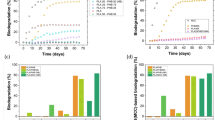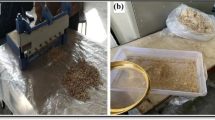Abstract
In recent years, most of the scientific research had focused on developing environment-friendly biodegradable materials after being used. There are two ways to do that: the first consists of the use of biodegradable plastics, and the second is the incorporation of biodegradable fibers in polymers. The main objective of this paper is to develop eco-friendly biodegradable biocomposites and to make their characterization. We devoted significant attention to investigate the use of alfa fiber as reinforcement in Poly (hydroxybutyrate-Co-valerate) (PHBV) material. The effects of fiber content and fiber treatment, as well as the biodegradation behavior of elaborated composites, have been investigated. From the main results, we observed some morphological changes that occurred on the fiber surface after chemical treatment. The use of fibers in PHBV increases the modulus but not necessarily improves the tensile strength of resulting composites but remains dependent on the interfacial adhesion. Alkali treatment of alfa fibers leads to improve the tensile strength and the rigidity of PHBV/alfa composites. SEM micrographs highlighted differences in microstructure of untreated and treated composites indicating that fiber-treatment also enhances the quality of the interface between the thermoplastic matrix and alfa fibers. In terms of degradability characteristics, the treated composites were highly biodegradable compared to both neat PHBV and untreated composites when subjected to water absorption in distilled and seawater. Also, elaborated composites undergo significant degradation into seawater, indicating their environmentally friendly character.









Similar content being viewed by others
References
Anjum S, Luisa M, Skrifvars M (2020) Mechanical performance of hybrid bast and basalt fibers reinforced. J Polym Res 27:61
Luo S, Netravali AN (1999) Interfacial and mechanical properties of environment-friendly “green” composites made from pineapple fibers and poly (hydroxybutyrate-co-valerate) resin. J Mater Sci 34(15):3709–3719
Rossa LV, Scienza LC, Zattera AJ (2013) Effect of curauá fiber content on the properties of poly (hydroxybutyrate-co-valerate) composites. Polym Compos 34(4):450–456
Guo X, Wang J (2019) The chemical behaviors of microplastics in the marine environment: A review. Mar pollut bull 142:1–14
Gewert B, Plassmann MM, MacLeod M (2015) Pathways for degradation of plastic polymers floating in the marine environment. Environ Sci Process Impacts 17(9):1513–1521
Andrady AL (2011) Microplastics in the marine environment. Mar pollut bull 62(8):1596–1605
Yohko T, Senri H, Miwa S, Phouvilay S, Yuya T, Ken-ichi K (2017) Identification of Cellulosimicrobium sp., a poly(3-hydroxybutyrate)-degrading bacterium isolated from washed rind cheese Pont-l’évêque lait cru. J Polym Res 24(10):159
Javadi A, Srithep Y, Lee J, Pilla S, Clemons C, Gong S, Turng LS (2010) Processing and characterization of solid and microcellular PHBV/PBAT blend and its RWF/nanoclay composites. Compos Part A Appl Sci Manuf 41(8):982–990
Richards E, Rizvi R, Chow A, Naguib H (2008) Biodegradable composite foams of PLA and PHBV using subcritical CO2. J Polym Environ 16(4):258–266
Miwa S, Yuya T, Jun-ichiro K, Reika T, Fumihiro M, Ken-ichi K (2017) Difference in environmental degradability between poly (ethylene succinate) and poly(3-hydroxybutyrate). J Polym Res 24(12):217
Wang Y, Chen GQ (2017) Polyhydroxyalkanoates: sustainability, production, and industrialization. Sustainable polymers from biomass, Wiley VCH, Weinheim, Germany, p 14
Vroman I, Tighzert L (2009) Biodegradable polymers Materials 2(2):307–344
Ahankari SS, Mohanty AK, Misra M (2011) Mechanical behavior of agro-residue reinforced poly (3-hydroxybutyrate-co-3-hydroxyvalerate) (PHBV) green composites: A comparison with traditional polypropylene composites. Compos Sci Technol 71(5):653–657
Yan L, Chouw N, Jayaraman K (2014) Flax fiber and its composites-A review. Compos B Eng 56:296–317
Herrera-Franco PJ, Aguilar-Vega MDJ (1997) Effect of fiber treatment on the mechanical properties of LDPE-henequen cellulosic fiber composites. J appl polym sci 65(1):197–207
Aziz SH, Ansell MP (2004) The effect of alkalization and fiber alignment on the mechanical and thermal properties of kenaf and hemp bast fiber composites: Part 1-polyester resin matrix. Compos Sci Technol 64(9):1219–1230
Demir H, Atikler U, Balköse D, Tıhmınlıoğlu F (2006) The effect of fiber surface treatments on the tensile and water sorption properties of polypropylene-luffa fiber composites. Compos Part A Appl Sci Manuf 37(3):447–456
Bessadok A, Roudesli S, Marais S, Follain N, Lebrun L (2009) Alfa fibers for unsaturated polyester composites reinforcement: Effects of chemical treatments on mechanical and permeation properties. Compos Part A Appl Sci Manuf 40(2):184–195
Rokbi M, Osmani H, Imad A, Benseddiq N (2011) Effect of chemical treatment on flexure properties of the natural fiber-reinforced polyester composite. Procedia Eng 10:2092–2097
Ikada Y, Tsuji H (2000) Biodegradable polyesters for medical and ecological applications. Macromol Rapid Commun 21(3):117–132
Berthet MA, Gontard N, Angellier-Coussy H (2015) Impact of fiber moisture content on the structure/mechanical properties relationships of PHBV/wheat straw fibers biocomposites. Compos Sci Technol 117:386–391
Isadounene S, Hammiche D, Boukerrou A, Rodrigue D, Djidjelli H (2018) Accelerated aging of alkali-treated olive husk flour reinforced polylactic acid (PLA) biocomposites: physico-mechanical properties. Polym Polym Compos 26(3):223–232
ASTM F 1635–04a (2004) Standard test method for in vitro degradation testing of hydrolytically degradable polymer resins and fabricated forms for surgical implants. Annual Book of ASTM Standards, Philadelphian
ASTM D-638–02 (2002) Standard Test Method for Tensile Properties of Plastics, Annual Book of ASTM Standards
De Rosa IM, Kenny JM, Puglia D, Santulli C, Sarasini F (2010) Morphological, thermal, and mechanical characterization of okra (Abelmoschus esculentus) fibers as potential reinforcement in polymer composites. Compos Sci Technol 70(1):116–122
Hammiche D, Boukerrou A, Djidjelli H, Grohens Y, Bendahou A, Seantier B (2016) Characterization of cellulose nanowhiskers extracted from alfa fiber and the effect of their dispersion methods on nanocomposite properties. J Adhes Sci Techno 30(17):1899–1912
Ouajai S, Shanks RA (2005) Composition, structure, and thermal degradation of hemp cellulose after chemical treatments. Polym DegradStab 89(2):327–335
Sgriccia N, Hawley MC, Misra M (2008) Characterization of natural fiber surfaces and natural fiber composites. Compos Part A Appl Sci Manuf 39(10):1632–1637
Singh S, MohantyA K (2007) Wood fiber reinforced bacterial bioplastic composites: Fabrication and performance evaluation. Compos Sci Technol 67(9):1753–1763
Singh S, Mohanty AK, Sugie T, Takai Y, Hamada H (2008) Renewable resource-based biocomposites from natural fiber and polyhydroxybutyrate-co-valerate (PHBV) bioplastic. Compos Part A Appl Sci Manuf 39(5):875–886
Bessadok A, Marais S, Gouanvé F, Colasse L, Zimmerlin I, Roudesli S, Métayer M (2007) Effect of chemical treatments of Alfa (Stipa tenacissima) fibers on water-sorption properties. Compos SciTechnol 67(3–4):685–697
Hammiche D, Boukerrou A, Djidjelli H, Corre YM, Grohens Y, Pillin I (2013) Hydrothermal aging of alfa fiber reinforced polyvinyl chloride composites. Constr Build Mater 47:293–300
Imam SH, Gordon SH, Shogren RL, Tosteson TR, Govind NS, Greene RV (1999) Degradation of starch-poly (β-hydroxybutyrate-co-β-hydroxyvalerate) bioplastic in tropical coastal waters. Appl Environ Microbiol 65(2):431–437
AS Harmaen A Khalina HM Ali I Azowa 2016 Thermal morphological and biodegradability properties of bioplastic fertilizer composites made of oil palm biomass fertilizer and poly (hydroxybutyrate-co-valerate) Int J Polym Sci 2016
Rydz J, Sikorska W, Kyulavska M, Christova D (2015) Polyester-based (bio) degradable polymers as environmentally friendly materials for sustainable development. Int J Mol 16(1):564–596
Muhamad II, Lee KJ, Noor MAM (2006) Comparing the Degradation of Poly-β-(hydroxybutyrate), Poly-β–(hydroxybutyrate-co-valerate)(PHBV), and HBV/Cellulose Triacetate Blend. Malaysian Polymer Journal 1(1):39–46
Altaee N, El-Hiti GA, Fahdil A, Sudesh K, Yousif E (2016) Biodegradation of different formulations of polyhydroxybutyrate films in soil. SpringerPlus 5(1):1–12
Bond T, Ferrandiz-Mas V, Felipe-Sotelo M, van Sebille E (2018) The occurrence and degradation of aquatic plastic litter based on polymer physicochemical properties: a review. Crit Rev Environ Sci Technol 48(7–9):685–722
Acknowledgment
I would like to dedicate this paper to my father whose sudden and untimely death provoked his leave. Thanks for always being there for me. You not gone; you remain here beside me. Just in a different form, in my heart forever.
Funding
As a corresponding author of this manuscript and on behalf of all co-authors, I would like to declare that there is no conflict of interest regarding the publication of this paper. This work received no specific subvention from any funding agency in the public and commercial sectors.
Author information
Authors and Affiliations
Corresponding author
Additional information
Publisher's Note
Springer Nature remains neutral with regard to jurisdictional claims in published maps and institutional affiliations.
Rights and permissions
About this article
Cite this article
Hammiche, D., Boukerrou, A., Grohens, Y. et al. Mechanical properties and biodegradation of biocomposites based on poly (hydroxybutyrate-co-valerate) and alfa fibers. J Polym Res 27, 308 (2020). https://doi.org/10.1007/s10965-020-02284-1
Received:
Accepted:
Published:
DOI: https://doi.org/10.1007/s10965-020-02284-1




